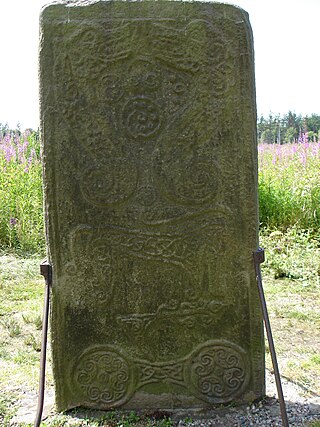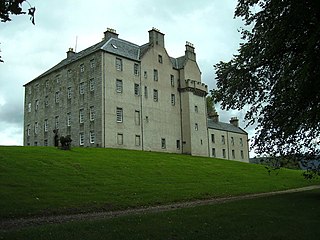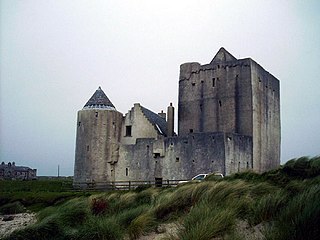
Balvenie Castle is a ruined castle 1 km north of Dufftown in the Moray region of Scotland.

Findlater Castle is the old seat of the Earls of Findlater and Seafield, sitting on a 50-foot (15 m)-high cliff overlooking the Moray Firth on the coast of Banff and Buchan, Aberdeenshire, Scotland.

Muness Castle is located on Unst, which is one of the Shetland Islands of Scotland. The castle is 3 kilometres (1.9 mi) east of the village of Uyeasound. Unst is Scotland's most northerly inhabited island, and Muness is the most northerly fortalice in the British Isles. It was designated as a Scheduled monument in 1953 and is run as a museum by Historic Environment Scotland.

Crawford Castle, substantially in ruins, is located on the north bank of the River Clyde, around 1⁄2 mile north of Crawford, South Lanarkshire, Scotland. The ruins stand on an earlier motte and bailey earthwork. The castle is also known as Lindsay Tower, after its former owners, the Lindsay family. The strategic location of the castle, at NS954213, guards the strategically important Mennock Pass from England into the upper Clyde Valley.

Loch Doon Castle was a castle that was located on an island within Loch Doon, Scotland. The original site and the relocated remains are designated as scheduled ancient monuments.

Closeburn Castle is a privately owned tower house, probably of the 14th century, but possibly older, and is one of the oldest continually inhabited houses in Scotland. The castle is located 1 km east of the village of Closeburn, in the historical county of Dumfriesshire, 2 km south-east of Thornhill, in Dumfries and Galloway, Scotland.

Rodney's Stone is a two-metre high Pictish cross slab now located close on the approach way to Brodie Castle, near Forres, Moray, Scotland. It was originally found nearby in the grounds of the old church of Dyke and Moy. It is classed as a Class II Pictish stone, meaning that it has a cross on one face, and symbols on the other. On the symbols face, at the top, are two fish monsters; below is a "Pictish Beast", and below that a double disc and Z-rod. On the cross face there is a cross and some animals.

Clan Stewart is a Scottish Highland and Lowland clan. The clan is recognised by Court of the Lord Lyon; however, it does not have a clan chief recognised by the Lord Lyon King of Arms. Because the clan has no chief it can be considered an armigerous clan; however, the Earls of Galloway are now considered to be the principal branch of this clan, and the crest and motto of The Earls of Galloway's arms are used in the Clan Stewart crest badge. The Court of the Lord Lyon recognises two other Stewart/Stuart clans, Clan Stuart of Bute and Clan Stewart of Appin. Stuart of Bute is the only one of the three clans at present which has a recognised chief.

Castle Grant stands a mile north of Grantown-on-Spey and was the former seat of the Clan Grant chiefs of Strathspey in Highlands, Scotland. It was originally named Freuchie Castle but was renamed Grant in 1694. The castle is a Category A listed building and the grounds are included in the Inventory of Gardens and Designed Landscapes in Scotland.

Knockhall Castle is a historic Scottish castle near to Newburgh, Aberdeenshire.

Brahan Castle was situated 3.5 miles (5.6 km) south-west of Dingwall, in Easter Ross, Highland Scotland. The castle belonged to the Earls of Seaforth, chiefs of the Clan Mackenzie, who dominated the area.

Dingwall Castle was a medieval fort and royal castle in the town of Dingwall, eastern Ross-shire, Scotland.

Breachacha Castle is either of two structures on the shore of Loch Breachacha, on the Inner Hebridean island of Coll, Scotland. The earlier is a 15th-century tower house that was a stronghold of the Macleans of Coll, the island having been granted to John Maclean in 1431. This castle was superseded by a new dwelling in 1750 but continued to be occupied for a time. It fell into a ruinous state only in the mid-19th century.
Kirkwall Castle, also known as King's Castle, was located in Kirkwall, the main settlement in the Orkney Islands of Scotland. Built in the 14th century, it was deliberately destroyed in 1614. The last ruins were cleared in the 19th century. The castle was located around the corner of Broad Street and Castle Street in the centre of Kirkwall.
Forres Castle was a fort and castle built near Forres, Scotland. The fort was destroyed in 850 by Vikings. Forres was created a royal burgh by King David I of Scotland in 1140. The castle, once a royal castle, was built as a motte and bailey castle and was strengthened in the 14th century. It was demolished in 1297 by the adherents of Wallace. King William the Lion and King Alexander II of Scotland visited and stayed at the castle. King David II of Scotland stayed at the castle in 1346. It was burned by Alexander Stewart, Earl of Buchan in 1390. Held by the Dunbars of Westfield until the 17th century, it fell into ruins. Nothing now remains above ground.
The siege of Inverness of 1429 was a conflict between Alexander of Islay, Earl of Ross and the Scottish crown. Alexander of Islay besieged the royal Inverness Castle and burnt the town of Inverness to ashes.
Blairfindy Castle is an L-plan tower house, dating from the 16th century, around 6.5 miles (10.5 km) north of Tomintoul, and west of the River Livet. The tower was a hunting seat of the earls of Huntly.
Weem Castle is a former castle near Weem, Scotland. The castle was located near Castle Menzies.
Deskie Castle was a medieval tower house that is thought to have been near Bridgend of Livet, Moray, Scotland.

Inveravon is a parish in the council area of Moray, Scotland. It lies in the lower reaches of the River Avon and includes the settlement of Ballindalloch.















